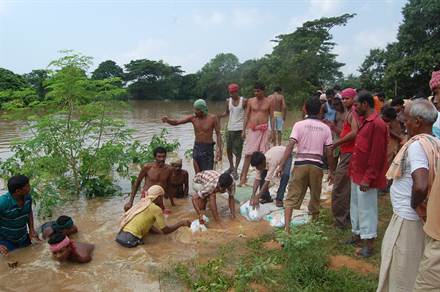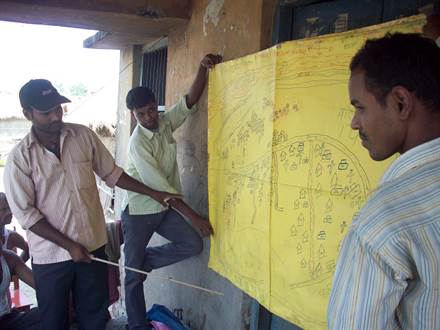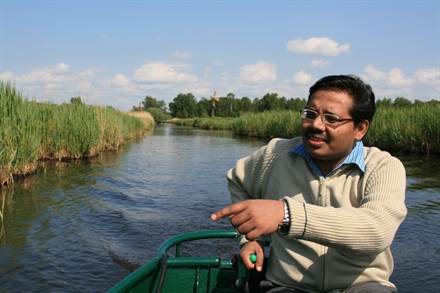
Living with floods in the Mahanadi Delta, India
-
Aquaculture, fisheries and coastal agriculture
-
Coastal wetland conservation
-
Community resilience
-
Integrated delta management
In October 2013, one of the fiercest cyclones to hit the Bay of Bengal for many years made landfall on the low-lying delta coast of the Indian state of Odisha. With winds battering the coastline at more than 200 kilometres per hour, the structural damage from cyclone Phailin was intense. Thousands of straw, timber and bamboo homes were destroyed across the delta of the River Mahanadi, one of India’s largest deltas. Trees were uprooted, cars upturned and power lines broken across the delta as high winds were accompanied by a three-metre storm surge.
Memories were stirred of the last “super-cyclone” Kalinga, which hit the same area in 1999 and claimed more than 10,000 lives. And yet this time it was different. When the winds were stilled, a million people were safely in shelters, with only 59 deaths reported.

One reason was the work of Wetlands International, CARITAS India and their local partner organisations. When I visited six months later, villagers spoke of how they had been trained to establish disaster committees, set up family survival kits, and develop escape plans to reach government shelters.
When they returned to their villages after the cyclone, many could call on grain banks they had built up, a handful of rice grains and black gram lentils at a time, over the preceding months. And, thanks to the alliance’s schemes, more than 700 toilets and 300 hand pumps had been raised on concrete platforms to keep them clear of flood waters.
It was a success for humanitarian action and social resilience. But while lives had been saved, much of the natural infrastructure that helped protect communities against cyclones and storm surges from the ocean had been badly damaged. Along much of the delta’s 200 kilometre coastline, mangroves were uprooted, and shelter-belt forests planted on dunes to take the force of the storm and surges were buried in sand.
And there was more to come. The cyclone had dumped heavy rains across the whole catchment of the River Mahanadi, an area the size of England and extending far inland from the delta. Soon that rain was swelling the river – and heading for the low-lying delta. As the Indian Express put it a month later, “just as the people were congratulating themselves for surviving the cyclone, they were hit by a wave of flooding that few had bargained for.”

Within two days, the rivers flooded large parts of the delta. More trees were washed away. Embankments designed to prevent floodwaters covering the land, came under siege. The highest banks simply channelled the water into ever higher and faster flows towards the lower banks, which were overwhelmed. Once inside the banks, the water was trapped on waterlogged fields, inundating schools and homes, smearing paddy fields with mud and sand.
A month later there was still devastation. So with lives protected, here is the new problem: how to save livelihoods and revive vital ecosystems. The events after Phailin emphasised dramatically the reason that ecosystem management is such a central element in the work programme of Wetlands International and its partners; without attention to ecosystems and livelihoods, disaster protection will not work.
The Indian Expresss: “Just as the people were congratulating themselves for surviving the cyclone, they were hit by a wave of flooding that few had bargained for.”
Wetlands International and its partners are working in a total of 184 villages in both the Mahanadi delta and the Ganges floodplain in Bihar to the north. Much has been done since the programme got underway on the delta in 2011. To help make livelihoods more disaster-proof, staff distributed flood-resistant rice varieties to most of the villages where it worked, helped 25 villages restore ponds to store water, and stocked many of them with fingerlings. Villagers received training in fish farming and growing vegetables, and help in re-establishing plantations of betel vines, a valuable local cash crop.
To bolster environmental resilience against floods, the alliance network helped delta people in 69 villages plant 140,000 saplings to stabilise river banks and coastal defences. In places, silted up rivers were dredged.
But there is a limit to what individual villages can achieve, said Ritesh Kumar, conservation programme manager of Wetlands International South Asia. While they can provide some protection by reviving ecosystems within their borders, none of this will ultimately work unless the delta landscape as a whole is right. And right now there is a great deal wrong. He believes that villages need to band together to address inter-village issues and to lobby governments for protection against bigger forces that exacerbate coastal erosion, increase flood flows coming down the river into the delta and restrict the delta’s ability to absorb floods from either land or sea.
Wetlands International, in partnership with government bodies such as the Integrated Coastal Zone Management Programme (ICZMP), is exploring how landscapes can be managed and enhanced in ways that provide both economic development and security from disaster.
Severe storms appear to be becoming more frequent in the Bay of Bengal. During the 1960s there were only three flood events on the Mahanadi delta; in the first decade of the new century there were seven. But the problem is not just climate change; it is at least as much due to changing land use.

Since 1975, a third of the delta’s wetlands have been lost to farm drainage schemes, ports, industrial plants and prawn farms. Wetlands once absorbed excess flow, while mangroves on the coast absorbed some of the tidal and wind force of cyclones. But the water, whether from storm surges or river floods, has to go somewhere. And all too often, the water has ended up trapped behind embankments in stagnant and waterlogged fields.
“We need to rethink embankments. While they can provide local protection, they add to wider risk, because flood flows become concentrated – bursting through defences at the weakest point.”
Some measures make obvious sense. The ICZMP has an office on the Mahanadi delta and wants mangroves on the banks of all tidally-influenced rivers, creeks and mudflats along the delta coast. But, says Kumar, it is also vital to rethink how water on the delta itself is managed.
“Until two centuries or so ago, people were aligned to the floods in the way they used the area, with fishing and flood recession agriculture. But British engineers decided to increase rice production by managing the flood. It worked up to a point. But it reduced the resilience of the system.”
Communities that once lived with floods, benefitting from the fertile silt that they distributed across the delta, now live behind embankments. They are dependent on artificial fertiliser to replace the silt, and are increasingly vulnerable to major floods that can breach the defences. “All this increases disaster risk,” Kumar says. “We can’t go back, but we do need to introduce elements of the old regime. Living with floods is the key.” The result will usually be soft engineering, which nurtures rather than confronts natural processes. Floods must be given somewhere to go.
“We need to rethink embankments,” says Kumar. While they can provide local protection, they add to wider risk, because they restrict the ability of floods to spread across the land. Instead flood flows become concentrated – bursting through defences at the weakest point.

This landscape-level approach creates problems for agencies trying to encourage communitybased solutions for problems like flooding; collective protection cannot always be achieved simply by scaling up successful examples of protecting individual communities. “Working at the community level is not enough to reduce risk. Ecosystems work at a higher level. Scale is critical,” says Pieter van Eijk of Wetlands International. The danger is that villages might end up in a destructive race for better protection, in which each individual village’s gain damages other villages.
One way to encourage villages to think beyond their immediate vicinity is by linking up those with common problems, says Kumar. Most coastal villages on the delta, for instance, face the constant barrage of the ocean, cyclones and often coastal erosion and saline intrusion of freshwater aquifers. Working together they can avoid conflicts over embankments, and organise projects with collective benefits like setting up drainage systems to relieve waterlogged areas, organising dredging of silted rivers and planting shelter belts. In the central delta, villagers also face common risks from floods and waterlogging, while upstream villages at the head of the delta are confronted with droughts as well as floods.
Land use changes across the Mahanadi catchment are speeding the flow of rainwater into the river, and hence to the delta. This can be a problem even when there are no cyclones.
But there are other issues that must be addressed if these landscape-level problems are to be resolved. Many of these will require advocacy work with governments and sometimes corporations.
Along the delta coast, industrial developments such as iron and steel, cement, paper, fertiliser and power plants threaten coastal ecosystems such as mangroves and shelter belts through pollution, logging and cutting off fresh water inflows. And dredging to allow access for ships is changing coastal processes of erosion and deposition. Often, dredging increases the ability of ocean currents to erode unprotected coastline. The delta port at Pradeep alone dredges some two million cubic metres of sand and silt a year. The result, says the ICZMP, are coastal erosion rates of up to 100 metres a year in places.
Changes upstream also pose new risks to those living on the delta. Land use changes across the Mahanadi catchment are speeding the flow of rainwater into the river, and hence to the delta. This can be a problem even when there are no cyclones. A critical element here is the management of large dams able to control the flow of water downstream to the delta.
The Mahanadi flow is controlled by the Hirakud dam. Though completed by post-independence India, the dam was commissioned by a British governor, Sir Hawthorne Lewis, who promised in 1946, as he laid the foundation stone, that it would provide a “permanent solution” to floods on the Mahanadi delta.
That never happened, in part because the dam has other purposes too – to generate hydroelectricity and ensure a supply of water for irrigation schemes. But these needs encourage the dam’s managers to keep the reservoir as full as possible, whereas flood protection requires keeping the reservoir as empty as possible, reserving space to capture flood waters.
Since Hirakud’s completion, floods have increased rather than being banished. It is true, says Kumar, that much of the flooding on the delta is caused by rainfall on the delta itself. But at times of very heavy rain, it can be exacerbated by rushed releases from the dam, sometimes required to prevent it from being damaged. Rather than increasing the resilience of delta communities, the operation of the dam leaves them more vulnerable than before to the most extreme flood events.

The task of finding landscape solutions to flooding and other disaster risks on the Mahanadi delta is clearly beyond the reach of the programme itself. But Wetlands International South Asia is working with the ICZMP and the Odisha State Wetland Management Authority to change the management regimes of both the Hirakud dam and the Rengali dam, on the River Brahmani, to address the water needs of downstream ecosystems and reduce disaster risks for delta communities.
Rather than increasing the resilience of delta communities, the operation of the dam leaves them more vulnerable than before to the most extreme flood events.
Kumar’s hope is that the discussion that Wetlands International and its partners are promoting about how the management of ecosystems and rivers can reduce risks will generate a wider debate to increase community resilience to disasters and climate change, including rising sea levels. Only integrated thinking about delta processes can once again make floods a source of resilience and prosperity. Cyclone shelters can save lives, but not livelihoods.
